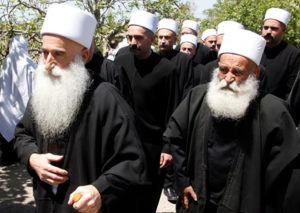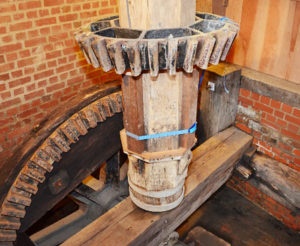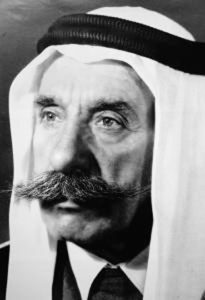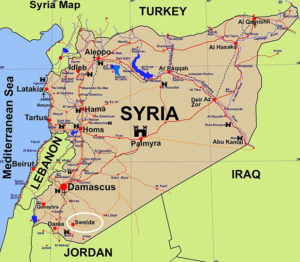A Syrian Reincarnates in Lebanon: The Druze Reincarnation Case of Hasan Hamed | Salem Andary
- CATEGORY
 How derived: Past Life Memories in Childhood
How derived: Past Life Memories in Childhood
Researcher: Ian Stevenson, MD
From: Cases of the Reincarnation Type, Volume III, Twelve Cases in Lebanon and Turkey, by Ian Stevenson, MD
Article by: Walter Semkiw, MD
The Life and Death of the Hasan Hamed
Hasan Hamed was the only son of Mahmoud Hamed and wife Hniyye. He was born in about 1927 in the village of Era, in Syria, which lies halfway in-between the towns of Krayye and Sweida. His father died when he was still a boy and Hasan went to live with his maternal uncles in Krayye, where he worked as a farmer, caring for vineyards and tending cattle.
Hasan is a Druze: A Group that Accepts Reincarnation
Krayye is in the southern area of Syria known as Djeble Druze, which is populated by the Druze people, who are an Arabic ethnic group, whose religious beliefs include the doctrine of reincarnation. Hasan’s family were members of the Druze. An image of Druze men in traditional garb is provided above. Click on images to enlarge them.
The Syrian government at the time was controlled by the French and between 1925 and 1927, the Druze mounted a military rebellion against the French. The leader of the revolt was Sultan Pasha Atrash. Though this revolution failed, the Sultan became a hero to the Druze people. Though Hasan was born towards the end of this rebellion, Hasan would have known about Sultan Pasha Atrash due to his hero status among the Druze. Whenever the Sultan traveled around Djeble Druze, a group of supporters on horseback escorted him.
 When Hasan was about 15 years of age, one of his cousins killed a Bedouin in the area. Bedouins are a group of nomadic Arabic people who inhabit the desert regions of North Africa, the Arabian Peninsula, Iraq and Syria. The word Bedouin derives from the Arabic term “badawi,” which means “desert dweller.” These people are divided into tribes, who survive by herding goats and camels. Bedouins are easily recognizable due to the distinctive clothing that they wear, which is featured in the image to the right.
When Hasan was about 15 years of age, one of his cousins killed a Bedouin in the area. Bedouins are a group of nomadic Arabic people who inhabit the desert regions of North Africa, the Arabian Peninsula, Iraq and Syria. The word Bedouin derives from the Arabic term “badawi,” which means “desert dweller.” These people are divided into tribes, who survive by herding goats and camels. Bedouins are easily recognizable due to the distinctive clothing that they wear, which is featured in the image to the right.
In the Bedouin culture of that era, when one of their members is murdered, the tribe must kill the murderer or a family member of the murderer.
Despite the danger that lurked, Hasan’s uncles asked him to take a flock of livestock from Krayye to the market in Sweida. A group of Bedouins ambushed Hasan along the road and threw him into the pit of a mill and then threw rocks down on Hasan’s body until it stopped moving. Hasan died on July 30, 1942.
His body was found three days later and it was noticed that there was a significant wound to the back of the head, though there were also wounds on both shoulders.
Hasan is Murdered in Syria and Reincarnates in Lebanon
Salem Andary was born in Fallujah, Lebanon on November 4, 1944, a little over two years after Hasan’s death. Fallujah is 15 miles east of Beirut, in the mountains of Lebanon. His father, a farmer, was Najm Andary and his mother’s name was Bahiyya. Soon after he was born, his mother noted a prominent bump on the back of his head, which she considered a type of birthmark.
When he began to speak, Salem’s first words were “Bedouin,” “stones,” and “hit.” One of his first phrases was: “Sultan kills a lot.”
When he was four years of age, he gave a detailed account of a past lifetime. He said that his name was Hasan Hamed and that the lived in Krayye. Salem related that he was a friend of Sultan Pasha Atrash and described the power and status of the sultan. Whenever little Salem saw a group of policemen or soldiers traveling in a group, he would exclaim: “Sultan Atrash is coming.” This was a reminiscence from his past lifetime as Hasan, who had witnessed Sultan Atrash with his entourage.
Salem said that in his past lifetime, he was the only son of his parents. He said that his father had died. Salem shared that he had uncles and that he tended vineyards in his past life. These statements were correct for the life of Hasan Hamed. Salem also said that he used to keep a rifle behind a door of the house he lived in.
Salem Remembers his Past Life Betrayal and Death
 Regarding his past life death, Salem stated that an uncle had killed a Bedouin and as a result, the Bedouins wanted revenge. One minor inconsistency is that it was reported that a cousin of Hamed had killed the Bedouin, not his uncle.
Regarding his past life death, Salem stated that an uncle had killed a Bedouin and as a result, the Bedouins wanted revenge. One minor inconsistency is that it was reported that a cousin of Hamed had killed the Bedouin, not his uncle.
Salem related that after the death of the Bedouin, his uncles let him go by himself to take sheep from Krayye to the market in Sweida. Salem claimed in doing so, his uncles exposed him to certain death. Indeed, the murder of the Bedouin occurred at the time of year that animals are taken to market to be sold. As such, the Bedouins could be sure that a member of Hasan’s family would traveling along the road from Krayye to Sweida at the time thatHamed was ambushed. As such, his uncles had set up Hasan to be a sacrificial lamb to the Bedouins to atone for the killing of their Bedouin kin.
Salem stated that Hasan was riding on a horse when the Bedouins attacked him. He related that he tried to escape, but his horse slowed down and the Bedouins caught up with him. He related that he was hit on the back of the head with a club and that afterwards, the Bedouins then threw him onto the floor of a mill. He claimed that he was still alive at that time, but that the Bedouins then threw stones down on his body, which caused him to die.
Salem’s Past Life Nightmares
Salem had repetitive nightmares about his past life death that were always identical. These nightmares were often stimulated by the sight of Bedouins or Syrians. The nightmares would begin with a “feeling” of how his uncles had betrayed him and how the Bedouins had caught up to him. He would then have clear images of the scenes that led up to the death of Hasan Hamed. Salem would then wake up at the moment in which he relived the death of Hasan.
 His parents would try to comfort him after his Bedouin nightmares. His mother found that she could only calm him by telling Salem that Sultan Pasha Atrash, pictured to the right, was coming. He was still having these nightmares about a half a dozen times a year even when he was 23 years old in 1968. Salem also experienced headaches when he thought about his past life.
His parents would try to comfort him after his Bedouin nightmares. His mother found that she could only calm him by telling Salem that Sultan Pasha Atrash, pictured to the right, was coming. He was still having these nightmares about a half a dozen times a year even when he was 23 years old in 1968. Salem also experienced headaches when he thought about his past life.
Salem’s Bedouin nightmares are very similar to the nightmares of James Leininger, in which little James relived his death in a military plane crash during World War II. To review this case, please go to:
Reincarnation Case of James Huston, Jr. | James Leininger
Salem Acts as if He was Still Hasan, his Past Life Persona
When Salem was between four and five years of age, he would act as if he was still Hasan. When he saw someone on a horse or with a gun, he would say “this is my horse” or “this is my gun.” Salem would then run to the owner and try to take the horse or gun from this person.
Sometimes he would go to the door of his home and state, “my weapons are behind the door.” He would then try to open the door to fetch his imagined weapons. Salem explained that Hasan had kept a rifle on a cupboard behind a door.
As a child, Salem would become enraged at the sight of a Bedouin. An animosity towards Bedouins continued into adulthood. Once when working in a village where Bedouins lived, a coworker, who knew about his past life memories, teased Salem that these Bedouins were of the same tribe that killed Hasan. This provoked Salem to pick a fight with one of the Bedouins and Salem proceeded to beat the Bedouin up.
Salem demonstrated a strong interest in horses, which was unusual as his family had no horses and horses were uncommon in the mountain towns of Lebanon, such as Fallujah.
When Salem was a child, no attempts were made to investigate his past life memories.
Salem’s Past Life Memories are Verified
 In 1966, when Salem was 21 years old, he and his father traveled from Fallujah, Lebanon to Krayye, Syria, a distance a little over 100 miles, to attend the public funeral of a brother of Sultan Pasha Atrash. The location where Hasan was killed is about 8 miles south of Sweida and Krayye is a little further south, about 12 miles south of Sweida.
In 1966, when Salem was 21 years old, he and his father traveled from Fallujah, Lebanon to Krayye, Syria, a distance a little over 100 miles, to attend the public funeral of a brother of Sultan Pasha Atrash. The location where Hasan was killed is about 8 miles south of Sweida and Krayye is a little further south, about 12 miles south of Sweida.
Click on the map to enlarge it, to better appreciate the geographic details. Recall that Fallujah is just east of Beirut, so the route Hasan and his father took was essentially from Beirut to Sweida, which is highlighted by a white oval.
At that time, in 1966, they decided to investigate Salem’s past life memories and found that there had indeed been a youth named Hasan Hamed in Krayye, who matched the past life statements of Salem, including the manner of death.
In their travel, Salem recognized the spot on the road between Krayye and Sweida where the Bedouins had attacked Hasan and struck him on the back of the head with a club. At this geographical spot, Salem actually felt pain in the back of his head and he placed a hand there.
Salem also found the mill in which the Bedouins had thrown Hasan’s body, though the mill was now in ruins. He also recognized the house that Hasan had inhabited in Krayye.
Ian Stevenson, MD Meets Salem Andary
Ian Stevenson, MD first met Salem about two years later on March 10, 1968, when Salem was 23 years of age. In contrast to most childhood past life memory cases, where past life recollections fade at about seven years of age, Salem told Dr. Stevenson that he still had full memory of his past life. Stevenson determined that the families of Salem Andary and Hasan Hamed had no familial relationship and no prior contact.
Past Lives for George and Amal Clooney
Of interest, Amal Clooney’s father belongs to the Druze ethnic group, which raises the question of whether Amal accepts reincarnation. Past lives for George and Amal have been posted. To review these, please go to:
Reincarnation Cases of Clark Gable | George Clooney and Loretta Young | Amal Clooney
Principles of Reincarnation-Understanding Past Lives
Change of Nationality: Hasan Hamed was a Syrian from Krayye, whereas Salem was born in Fallujah, Lebanon. If people understood that one can be born in different countries from one lifetime to another, wars and conflicts between nations would be mitigated.
Past Life Birthmark: Soon after Salem was born, his mother noted a large bump on the back of his head, which corresponded to the location that Salem said that a Bedouin had struck him with a club during the attack on Hasan Hamed, his past life persona.
Geographic Memory: Salem recognized the location where he was attacked by Bedouins and the mill that Hasan’s body was thrown into.
Source: Stevenson, Ian: Cases of the Reincarnation Type, Volume III, Twelve Cases in Lebanon and Turkey, University Press of Virginia, Charlottesville, pages 159-174